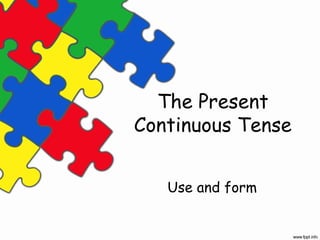Pres cont2.pptx
- 1. The Present Continuous Tense Use and form
- 2. What is she doing? • She is reading a book.
- 3. What is she doing? • She is crying.
- 4. What’s he doing? • He’s watching TV.
- 5. Where’s he going? • He’s going to school.
- 6. And what are you doing right now? • We are studying English grammar.
- 7. Use 1 • The previous examples show that we use this tense to denote an action happening at the time of speaking (adverbs: now, right now, at the moment)
- 8. What are they wearing today? • They are wearing T-shirts and mini skirts today.
- 9. I’d love to see you. Are you busy? • Unfortunately, I’m rather busy. I’m painting my flat this week.
- 10. Are you having fun this summer? • Not really. I’m working as a waiter. I need some money for college.
- 11. Use 2 • These examples show that the Present Continuous Tense is also used to denote a temporary action happening today or these days.
- 12. What’s wrong with our planet? • It’s getting warmer.
- 13. What’ wrong with the air we breathe? • It’s becoming more and more polluted.
- 14. Use 3 • It is also used to express the ongoing changes, especially with verbs such as become, get, grow, change, and with expressions like more and more.
- 15. • Are you going to the party on Friday?
- 16. • We’re leaving tomorrow.
- 17. Use 4 • We use it for future arrangements with a time reference.
- 18. Form – am, are, is + ing form am, is, are + ing form • Affirmative I am sleeping. He/she/it is sleeping. You/we/they are sleeping. • Negative I am not (I’m not) singing. He/she/it is not (isn’t) singing. You/we/they are not (aren’t) singing.
- 19. Form - continued • Interrogative Am I dreaming? Is he/she/it dreaming? Are you/we/they dreaming? • Short answers Yes, I am/he is/we are… No, I’m not/he isn’t/we aren’t…
- 20. ing form – spelling rules • Most verbs just take –ing with no changes in spelling: watch-watching, clean-cleaning, listen-listening • Verbs ending in –e drop it before –ing: live-living, write-writing • Verbs with short vowels and one consonant double the consonant: run-running, swim-swimming
- 21. ing form – spelling rules • Verbs ending in –l, double it: travel- travelling, cancel-cancelling • Verbs ending in –ie change it to –y: lie- lying, die-dying





















